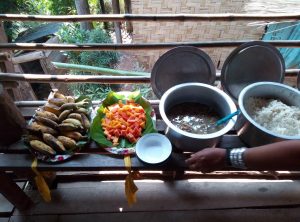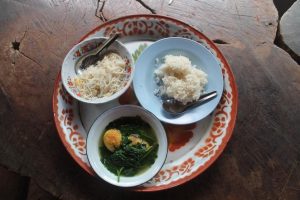Huay Sua Thao, also known as Huay Pu Keng, is a unique and sustainable travel destination in Northern Thailand. this community-based tourism (CBT) initiative offers visitors an authentic cultural experience while empowering the local Kayan community.
Contents
The story behind the Kayan rings
One of the most distinctive cultural practices of the Kayan people is the tradition among their women of wearing brass rings around their necks. As a result These rings create the illusion of an elongated neck. The Kayan (also known as Padaung ) are a small ethnic group originally from the Kayah State in Myanmar. Due to political conflicts in 1943 many of them migrated to Thailand and settled in villages Huay Pu Keng.

In Thailand, the government regarded them as potential tourist attractions, seeing an opportunity for profit primarily through photography by visitors.
This led to a backlash from human rights organizations, which pushed for a more ethical tourism model focused on sharing the Kayan people’s traditions and values rather than exploiting them. This approach, called Community-Based Tourism (CBT), fosters a more equal and respectful exchange between visitors and locals.
Why do Kayan wear neck rings?

There are various explanations for this tradition. The main reasons for wearing this ring include:
-
A Symbol of Beauty: Women who wear the rings are often regarded as more attractive within their community.
-
Cultural Identity & Tradition: The neck rings are a distinct cultural marker of the Kayan people, helping them preserve their heritage and traditions despite displacement and modernisation.
-
Social Status & Community Bonding: Women who follow this tradition may receive more respect within their society.
-
Myth & Folklore: Some legends suggest that the rings were originally meant to protect women from being taken by rival tribes or even to make them resemble dragons, which are sacred in Kayan folklore.

How Do the Neck Rings Work?
The rings do not actually elongate the neck. Instead, they push down the collarbone and compress the ribcage, creating the illusion of a longer neck.

While some Kayan women continue to wear the rings with pride, others choose not to, especially as they gain access to education and different opportunities.
Why Visit Huay Pu Keng?
There are two different communities, the most known show villages in which tourists come to only take pictures of the Kayan, while the second is the one that has been established in Huay Pu Keng, which adopts Community-Based Tourism. In this case, the village of Huay Pu Keng which is found in Northern Thailand, offers Community-Based Tourism which aims at protecting nature and providing the community with an equal and fair treatment, by giving them an equitable income and keeping their dignity as human beings. These are the reasons for visiting Huay Pu Keng:
-
Authentic Cultural Immersion: Huay Pu Keng is home to the Kayan people, known for their traditional brass neck rings. Unlike other commercialized “show villages,” Huay Pu Keng allows visitors to engage with locals, understand their traditions, and support their livelihoods.
-
Sustainable Tourism & Ethical Travel: Community-Based Tourism promotes a responsible way to travel by preserving cultural heritage and protecting nature. Your visit directly contributes to the local economy, ensuring the well-being of the Kayan community.
-
Workshops & Hands-on Experiences
Engage in traditional Kayan crafts through interactive workshops:
- Bamboo cup making
- Bracelet crafting
- Traditional weaving
There are various workshops on offer in Huay Pu Keng. A local resident will show you how skillful they are in their craft and teach you how to do it. You will be creating something that is traditionally Kayan, in a traditional way. In the end, you can of course take your self-made product back home with you as a memory of the trip. Take a look at the leaflet on the right for more information about the various workshops that are available, the costs, and how long they take.
Meals are not provided during the workshops, but the residents are more than happy to prepare a traditional meal for you for only 100 baht (€2.80).
“We have done a workshop making a bracelet during our visit to Huay Pu Keng. During this workshop you really connect to the people living there. They are open for contact and love to talk about their daily life. (…) After the workshop we had a delicious local lunch. For a real and local experience I really recommend one of the workshops!” – Jasmijn Grundel (former employee at Better Places)
The Community-Based Tourism team of Huay Pu Keng meets with the villagers every month to assess who wants to work in tourism and in what way. They discuss what is going well, what needs to change and if there are any new projects to include. This team for instance consists of representatives of the various workshops:
- Noung: village chief
- Aye Muang: bookings and overall organization
- Pay Yu: organization and homestays
- Maung Htan: bamboo cup workshops
- Nyaw La: bracelet making workshops
- Ma Pang: weaving workshops
- Luka: Nature conservation
Attractions Near Huay Pu Keng
At almost every shop there are fake rings available for tourists to try on,Even though the fake rings are half the weight of the rings which the Kayan women wear, because it are just halve circles, it is still very heavy to wear on your neck. Also notice the clothing of the female tourist, it is respectful to cover the shoulders and the knees, but often tourists do not know about this or are ignorant to this fact. Maway, our host in Huay Sua Thao, told us that in the beginning, she was completely in shock when tourists entered the village scantly dressed. Now she is used to it.

Huay Pu Keng is located in the region of Mae Hong Son, which is rich in attractions ranging from natural to cultural interests. Here you will find a list of the most loved touristic sites, which vary from isolated to crowded locations, depending on your preferences.
Nature attractions
Jungle and river Pai : If you are looking for a very local and adventurous experience, accommodating in an isolated village with guest houses, you can hike in Chiang Mai and fish in Pai river. Due to its isolated location, it is a very authentic and unique experience, which can include for example hill tribe tracks.
Mae Hong Son loop : Would you like to drown into the Thai nature, but don’t have the physical ability to do so? You can rent a motorbike and discover the main natural characteristics of the area through the Mae Hong Son loop, which is a popular road in the region
Tham Lot Cave : Are you a lover of caves, particularly of rocks? The Tham Lot Cave is the longest cave in Thailand, which consists in a mix of a romantic and wild experience
Mae Sariang : Are you looking for a place to rest your mind, frequented mostly by backpackers? Mae Sariang is the perfect location, surrounded by an authentic experience which also includes the possibility to visit temples, hill tribes’ villages and many more.
National and protected Parks : Namtok Mae Surin National Park is a loved park which includes caves, waterfalls, and mountains. While the Pang Tong Royal Development Project is a stunning protected park in which many hill tribes are living. There are also lakes and beautiful hikes that can be don
Cultural & Historical Landmarks
- Sacred Kayan New Year Celebration (Poi Ton Tee): In Huay Pu Keng there is a sacred site where the Kayan celebrate their new year. The festivities last for three days and include a diverse range of activities. According to resident Pay Yu, the highlights are the “music and dance celebration, and sportive competitions, like football and volleyball. It’s based on animism, reflecting the World’s creation by their own god, through a pole planted in the soil.
Every year, we erect a symbolic decorated stem and celebrate around it for luck and good health. There are more than 400,000 Kayan people in the world and during Poi Ton Tee, we all celebrate. Tourists are very welcome to join us.
- Mae Hong Son Burma style temples: While Thailand has plenty of temples, the Burma temples in Mae Hong Son are particularly authentic. Due to the close border with Burma, many temples have been built there in the past. Their most attractive characteristics are the enormous Buddha in each temple and their architectural structures.
- Buat Luk Khaeo Festival: This is the most colorful official celebration of the country, in which boys between 10 and 13 years old are ordained as novice monks. This colourful event occurs at the beginning of April, in conjunction with other celebrations such as Songkran and the Buddhist New Year.
- Wat Phra That Doi Kong Mu: This is a perfect expedition if you love both nature and Thai culture. After a half-hour trek in the forest, you will arrive at a temple introduced by two lion statues, with one of the most stunning views of Mae Hong Son.
How to Get to Huay Pu Keng
There are various ways to get to Huay Pu Keng,
- Boat Ride Across the Pai River: we would like to recommend crossing the river Pai using a boat from the villagers. This costs 325 baht per person and includes the entrance fee. In addition, the money goes directly to the residents themselves, which supports CBT. This boat ride lasts for about an hour and it is a great opportunity to look at the jungle surrounding Huay Pu Keng. It’s a beautiful experience!
Address: Huay Pu Keng, Pha Bong, Mueang Mae Hong Son District, Mae Hong Son 58000, Thailand.
Where to stay?
There is a possibility to stay overnight in Huay Pu Keng in a homestay for 400 baht per night. The residents love to let you experience their traditional dishes, so you only have to ask. The money earned from this goes straight into the village fund. For more information or in order to book, click here .
If you would not like to book an accommodation in advance, you can always try to arrange it when you have arrived in Huay Pu Keng. However, there is no guarantee that you will be able to stay the night, because of the limited space.
The little house in Huay Pu Keng which tourists can rent for themselves.
It is no problem if you prefer not to stay in the village. About half an hour ride away is Changwat Mae Hong Son with a diverse range of accommodations. From local farms with a nice and cozy garden, to guest houses, hostels, camping’s, boat houses, hotels and luxurious resorts with swimming pools and buffets. Therefore, there is also a variety in prices from about 7-40 euros a night depending on the season and accommodation of choice.
Traditional foods to eat
In Huay Pu Keng it is possible to try the local Kayan food for only 100 baht (€2.80)
or to participate in a workshop to learn how to make some of the traditional dishes.






